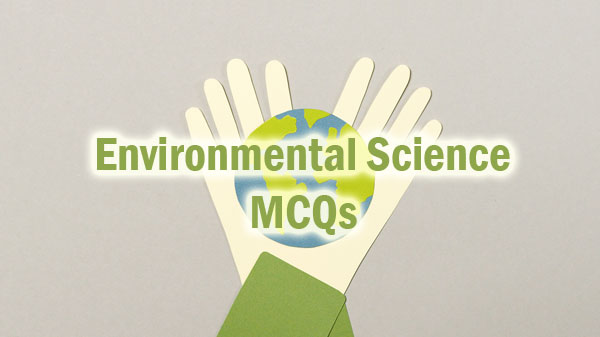Environmental Studies Sample Question
Download all Environmental Studies Sample Question Papers here. We are providing Environment Science Sample Question Papers. We have given the solutions for EVS solved Sample Question Papers to make your preparation efficient.

Click here to Download the Environment Science Sample Question Papers from the attached pdfs. EVS Sample Question Papers attached in the PDF Format so the aspirants can download quickly. Along with these Environmental Studies Sample Question papers, we have attached Environment Science Syllabus and Exam Pattern.
Environmental Studies Sample Question Papers are available. Applicants can download EVS Sample Question Papers. Also, get the Study material, Preparation tips in addition to the EVS Sample Question Papers for posts. On our page, we provide Environmental Studies Sample Question Papers for the sake of aspirants.
Sample Question on Environmental Studies
1. Public hearing is conducted:
(A) Prior to site selection
(B) Prior to approval of terms of reference
(C) After environmental clearance
(D) After preparation of Draft EIA
2. Which method for impact identification in EIA links action to impact?
(A) Overlays
(B) Matrices
(C) Checklists
(D) Ad hoc
3. What is the first step in environmental clearance?
(A) Project appraisal
(B) Project identification
(C) Project monitoring
(D) Project implementation
4. Extended Producer Responsibility is covered in:
(i) Construction and Demolition
(ii) Waste Management Rules, 2016.
(iii) Plastic Waste Management Rules, 2016.
(iv) E-Waste (Management) Rules, 2016.
(A) (i) and (ii)
(B) (i) and (iii)
(C) (ii) and (iii)
(D) All of the above
5. Contaminated waste (recyclable) is to be stored in which colour coded container as per the Biomedical Waste (Management and Handling) Rules, 2016:
(A) Yellow
(B) Red
(C) White
(D) Blue
6. Which of the following is not an objective of the National Forest Policy?
(A) Maintenance of environmental stability
(B) Checking soil erosion and denudation in catchment areas of rivers
(C) Conservation and protection of wildlife
(D) Increasing the forest/tree cover substantially in the country
7. Which Act led to the constitution of CPCB/SPCB’s?
(A) Air (P & CP) Act 1981
(B) Water (P & CP) Act 1974
(C) Wildlife Protection Act 1972
(D) Environmental Protection Act 1986
8. Which of the following standards from the ISO 14000 series is a normative standard?
(A) ISO 14001
(B) ISO 14020
(C) ISO 14040
(D) ISO 14015
9. What is the last date for submission of ESR to SPCB every year?
(A) 30 June
(B) 31 August
(C) 31 January
(D) 30 September
10. Anaerobic treatment of effluents has the following advantage:
(A) Reduction of COD/BOD
(B) Generation of methane
(C) Low power requirement
(D) All of the above
11. Which of the following sequences of unit operations in waste water treatment is correct?
(A) Grit removal -> Screening -> Clarification -> Biological treatment
(B) Screening -> Grit removal -> Biological treatment -> Clarification
(C) Biological treatment -> Screening -> Grit removal -> Clarification
(D) Screening -> Grit removal -> Clarification -> Biological treatment
12. The largest scale of biogeographic division of the land surfaces of the earth based on evolutionary distribution patterns of terrestrial plants and animals is …………
(A) Biogeographic realms
(B) Oriental realm
(C) Ethopian realm
(D) Neotrophic realm
13. Which is a decentralised system set up created by MOEFCC using distributed network of databases for collection of environmental information?
(A) ENVIS
(B) NEAC
(C) NCERT
(D) NMNH
14. Why is it good to buy Eco-marked products, because?
(i) These products have lower environmental impact.
(ii) Their production involves the use of non-renewable energy.
(iii) Buying such products makes a commitment to the future environment.
(iv) Products cannot be recycled.
(A) (i), (iv)
(B) (iii), (iv)
(C) (i), (iii)
(D) (ii), (iii)
15. The plants growing on soils with high salt concentrations are called …………….
(A) Cryptophytes
(B) Hemi-cryptophytes
(C) Halophytes
(D) Pteridophytes
16. Brown soils are generally associated with areas originally covered by:
(A) Ice
(B) Water
(C) Deciduous forest
(D) Mangrove forest
17. The addition of lime into the soil will:
(A) Increase porosity of soil
(B) Change soil texture
(C) Reduce soil acidity
(D) Cause decomposition of organic material
18. The loam soil is composed of:
(A) Clay + Sand
(B) Sand + Silt
(C) Sand + Gravel + Silt + Clay
(D) Sand + Gravel + Clay
19. The association between sea anaemone and Hermit crab is:
(A) Protocooperation
(B) Exploitation
(C) Predation
(D) Antibiosis
20. Which of the following sequence of general process of succession is correct?
(A) Stabilization -> Nudation -> Invasion -> Competition -> Reaction
(B) Nudation -> Invasion -> Competition -> Reaction -> Stabilization
(C) Invasion -> Nudation -> Competition -> Reaction -> Stabilization
(D) Competition -> Reaction -> Stabilization -> Invasion -> Nudation
More Questions on Environmental Science
21. An urn shaped age pyramid indicates:
(A) Declining population
(B) Stable population
(C) Young population
(D) Increasing population
22. A narrow zone of habitat transition tends to increase in variety and density of species is known as:
(A) Ordination
(B) Continuum
(C) Edge effect
(D) Ecotype
23. Electrostatic precipitators work on the principle of:
(A) Gravity settling
(B) Centrifugal separation
(C) Charge separation
(D) All of the above
24. What is the maximum limit for BOD of effluent to be discharged on land?
(A) 30 mg/L
(B) 100 mg/L
(C) 250 mg/L
(D) 10 mg/L
25. In an ecosystem one species inhibits by another species by releasing noxious or toxic substance is known as:
(A) Chelation
(B) Allelopathy
(C) Mesocosms
(D) Microcosm
26. What is the estimated per capita solid waste generation in the small towns of India?
(A) 0.1 kg
(B) 0.3 to 0.4 kg
(C) 0.5 kg
(D) 0.5 to 0.6 kg
27. Recent data on the vertical distribution of ozone in the atmosphere show:
(A) Increase in ozone both stratosphere and troposphere
(B) Decrease in ozone both in stratosphere and troposphere
(C) Decrease in stratospheric ozone and increase in troposphere ozone
(D) Increase in tropospheric ozone and decrease in stratosphere ozone
28. The range of sound frequencies for normal human conversation are …………..
(A) 500 to 2000 Hertz
(B) 10 to 10,000 Hertz
(C) 100 to 10,000 Hertz
(D) 50 to 5,000 Hertz
29. The sound velocity is high in the ………….. media.
(A) Liquid
(B) Solid
(C) Gases
(D) Vapors
30. What is the sound velocity in the air at 0°C?
(A) 1269 m/s
(B) 331 m/s
(C) 1435 m/s
(D) 5130 m/s
31. The last period’s forecast was 70 and demand was 60. What is the simple exponential smoothing forecast with alpha of 0.4 for the next period?
(A) 63.8
(B) 65
(C) 62
(D) 66
32. Which of the following is true regarding the two smoothing constants of the Forecast Including Trend (FIT) model?
(A) Their values are determined independently
(B) They are called alpha and beta, producer risk and consumers risk
(C) Alpha is always smaller than beta
(D) All of the above
33. The sampling procedure in which an interviewer is asked to interview 25 teachers, 50 public servants and 25 farmers is called:
(A) Stratified sampling
(B) Accidental sampling
(C) Spatial sampling
(D) Quota sampling
34. The Chi-square distribution is:
(A) Multimodal
(B) Symmetrical
(C) Continuous
(D) Discrete
35. In a partially destroyed laboratory record of an analysis of correlation data, the results only are legible as variance of X = 9 and regression equations are 8X – 10Y + 66 = 0 and 40X – 18Y = 214. What is the mean values of X and Y?
(A) 12 and 17
(B) 13 and 17
(C) 17 and 12
(D) 17 and 13
36. The probability of type one error is:
(A) Probability of rejecting null hypothesis (accepting alternative hypothesis) when null hypothesis is true
(B) Probability of accepting null hypothesis (rejecting alternative hypothesis) when null hypothesis is false
(C) Probability of rejecting null hypothesis (accepting alternative hypothesis) when null hypothesis is false
(D) Probability of accepting null hypothesis (rejecting) alternative hypothesis) when null hypothesis is true
37. In a series of 100 houses actually invaded by smallpox, 70% of the inhabitants are attacked and 85% have been vaccinated. What is the lowest percentage of the vaccinated that must have been attacked?
(A) 64.7%
(B) 63.7%
(C) 62.7%
(D) 61.7%
38. For a singular square matrix:
(A) its determinant is greater than zero
(B) its determinant is less than zero
(C) its determinant is equal to zero
(D) all of the above
39. Documentation of comprehensive information on availability and knowledge of local biodiversity resources is known as:
(A) Community biodiversity record
(B) People’s biodiversity registers
(C) Revenue record
(D) Panchayat record
40. National Biodiversity Authority is setup at:
(A) Bhopal
(B) Chennai
(C) Bhubaneshwar
(D) Ahemdabad
41. What is the full form of UNFCCC with respect to global warming convention?
(A) United Nations Framework Convention on Climate Change
(B) United Nations Federation Convention on Climate Change
(C) United Nations Framework Center on Climate Change
(D) United Nations Federation Center on Climate Change
42. Kaziranga National Park in Assam is known for:
(A) One horn Rhino
(B) Crocodile
(C) Bengal Tiger
(D) Bison
43. Tropical cyclones are most frequently observed in the Bay of Bengal during :
(A) July – August
(B) Jan. – Feb.
(C) March – May
(D) Oct. – Dec.
44. The dispersal of pollutants in air is dependent on :
(A) Wind speed only
(B) Wind speed and thermal stability both
(C) Thermal stability only
(D) Wind speed and humidity
45. Earth’s atmosphere is transparent to infrared radiation in the wavelength band which is called atmospheric window :
(A) 8 – 13 µ
(B) 14 – 17 µ
(C) 7 20 µ
(D) 5 – 7 µ
46. In an area where there are no land surface (open ocean) the albedo of the surface will be :
(A) Maximum
(B) Minimum
(C) More than bare soil
(D) More than wet soil
47. In an adiabatic process the ……………. remains unchanged.
(A) Temperature
(B) Entropy
(C) Density
(D) Pressure
48. If 10 calories of heat is added to a system which does not change its specific volume, then as per the first law of thermodynamics the change in internal energy of the system will be :
(A) Zero
(B) Positive
(C) Negative
(D) Either (A) or (C)
49. An inversion layer is seen between 1000 m to 1500 m. If the temperature at 1000 m is 280 K, what will be temperature at the top of the layer (negative lapse rate 1.0°C/100 m) ?
(A) 290 K
(B) 278 K
(C) 284 K
(D) 285 K
50. Subtropical jet stream with its core of strong winds (exceeding 60 kt) at nearly 200 hPa …………………. .
(A) Moves equatorward in summer
(B) Remains at same location in winter and summer
(C) Moves equatorward in winter
(D) Moves poleward in winter

